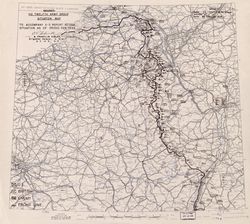 |
Lou Prucha WWII Service
|
 |
Unna, Germany
(Ordnance Depot)

Pilot's Flight Log |

12th Army Group Situation Map 28-Feb-1945 |
in Box 1, Flight 3, Position 4.
Click to display the official 416th Bomb Group Mission Folder, Mission Report and Operational Report
scanned to PDF files by the Air Force Historical Research Agency (AFHRA).
Group, Unit and Historical Extracts for Mission 217
"416th Bombardment Group (L) - Group History 1945"
Transcribed from USAF Archives
The last mission of the month, no. 127, was flown on the 28th. The target to be attacked was the still very important ordnance depot at Unna. A 10/10ths cloud cover hung over Germany. A last minute equipment failure in the PPF plane of the first box prevented it from bombing. It was too late for the box leader to make a Gee run. As a result, he led his box on to attack the marshalling yards a Seigen on his own Gee equipment. The PPF equipment worked fine in the second PPF plane so that the second box was able to attack the primary target. Twenty-eight and one-half tons of incendiary bombs were dropped on each of the targets. The box leaders were Major Dunn, Lts Brewer and Maltby as B and N, and Lt Rooney, Lts Kirk and Koch as B and N.
Despite the inclement February weather, our Group had flown 22 missions. This was only a few missions less than we had flown during some of our best operational months. On these missions, 707 individual sorties were flown and 1032 1/2 tons of bombs were dropped on enemy installations. A month-end summary published by the Public Relations Office ties our operations with the general plan of battle for the whole of the 9th Bombardment Division.
"Attack Bombers, We Need You! A History of the 416th Bomb Group"
Ralph Conte
Pages 215 - 216
Mission #217 - 28 February - Unna Communication Center. Major Dunn with Lts. Brewer and Maltby, BNs - Lt. Rooney with Lts. Kirk and Koch BNs led boxes. Lts. Stanley and Blount, BN, Lts. Anderson and Babbage, BN, Captain Tutt and Lt. Beck, BN with Lts. Lackovich and Muir, BN, led flights - Cloud cover required PFF pathfinders to lead the formation. The PFF unit ran into some difficulty and did not signal a drop, but the BN box leader, using his own GEE equipment went on to bomb a marshalling yard at Seigen with good results. The second box got to drop with their PFF leader, dropping incendiary bombs on the primary target. This facility included two dozen large buildings and barracks which were demolished. This was another milk-run - No fighters or flak.
"Operational History 668th Bomb Squadron (416th Bomb Group (L)) WWII"
Wayne Williams, et.al.
The mission today was briefed early, but didn’t take off till early in the afternoon. A hefty haze clings to the ground during the morning, and doesn’t usually clear till noon. On the loading list for Gp Mission # 217, were twelve crews, including the three B/N Teams of Stanley & Blount Jacobsen & Harvest, and Andersen & Babbage.
The ordnance depot at Unna, Germany was the target. The planes were loaded with 500 lb. GP’s, and they were dropped through the clouds at 12,500 feet, with the bombing being accomplished with "PFF" and "Gee".
The results of the bombing were again "undetermined", with a heavy cloud cover preventing the taking of any pictures. The formation returned safely to the base after four hours of flight. Flak was nil, thusly no damages, casualties, or losses.
This was # 1 for 2nd Lt. –eimet, although not at the stick, he rode with Lt. Parker and learned the feeling of a mission.
"History of 670th Bombardment Squadron (L)"
Transcription from USAF Archives
The Sindorf Communications Center was bombed on the 26th of February and Unna Ordnance Depot on the 28th to conclude the months operations.
"671st Bomb Squadron (L) Unit History"
Gordon Russell and Jim Kerns
Rounding out one of their most active months and one of their most important tactical assignments…supporting the drive to the Rhine River…the 416th Group struck at the Una Ordnance Depot and other targets in the vicinity on February 28th, 1945. Guns from this heavily defended target, which had knocked down eight ships of four groups on February 16th, were silent on this mission due to a solid cloud covering.
Box I bombed the Marshalling Yard at Seigen when the PFF failed at the Primary. The Group lead dropped on Gee. The Pathfinder aircraft of the second box bombed as scheduled and all planes of the Box dropped on it, hitting Una, with undetermined results.
This depot, 11 miles west of Dortmund, contains 20 large buildings and barracks. It is one of the three main ordnance depots supplying German troops on the Western Front with all types of equipment.
"USAAF Chronology of WWII, month by month"
TACTICAL OPERATIONS (Ninth Air Force): In Germany, 340+ A-20s, B-26s and A-26s bomb rail bridges at Mayen, Niederscheld, and Colbe, the Unna ordnance depot, Kamp road junction, Siegen and Sankt Wendel marshalling yards, the town of Rheinburg, and targets of opportunity; fighters escort the bombers, fly sweeps, patrols and armed reconnaissance, attack special targets, and support the US 3d Armored Division at the Paffendorf bridgehead, US Ninth Army elements near Monchen-Gladbach and Neuss [the 2d Armored Division reaches a point within 6 miles (9.7 km) of the Rhine River], and the VIII, XII, and XX Corps between the Prum and Kyll Rivers and near Trier.